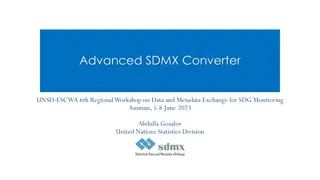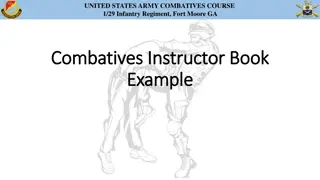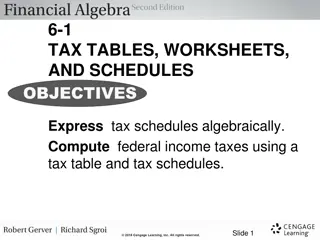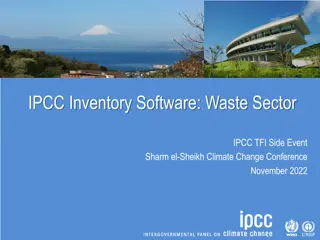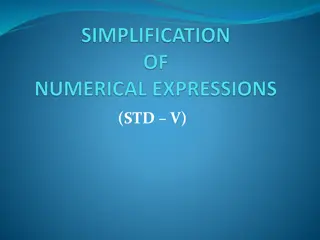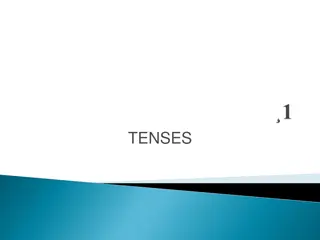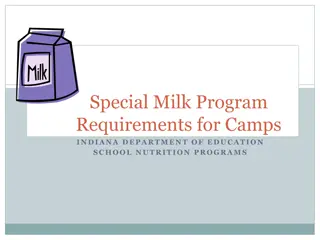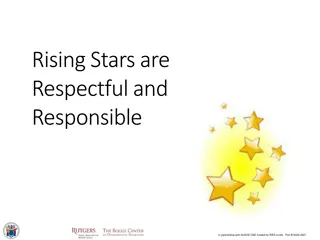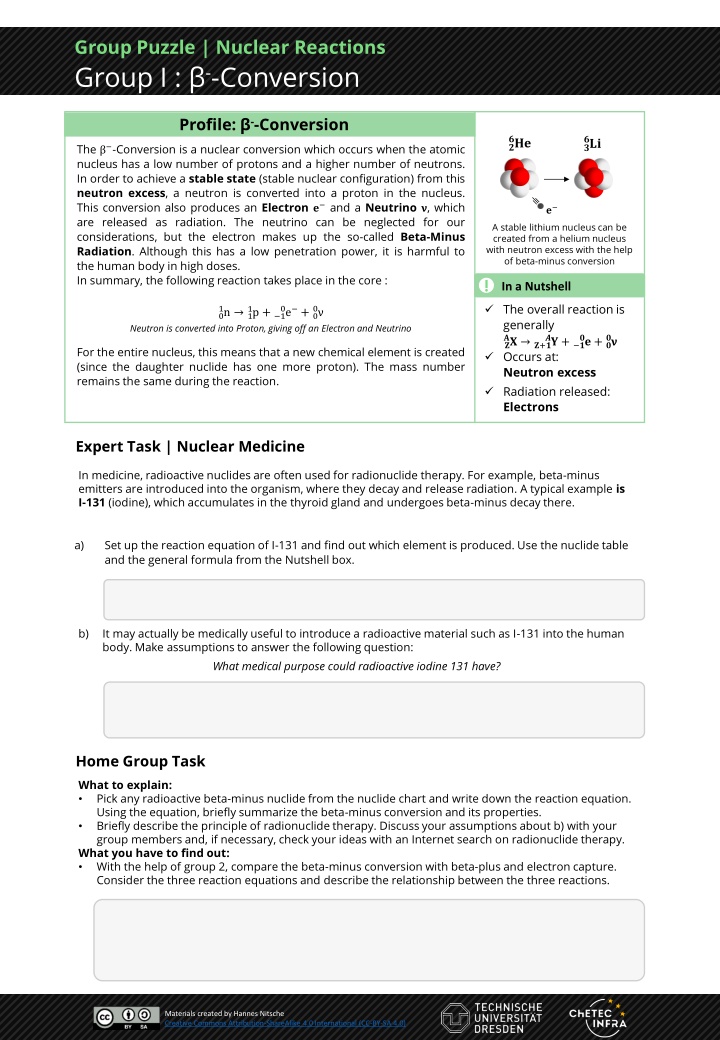
Nuclear Reactions Overview and Medical Applications
Explore nuclear reactions, including beta-minus and beta-plus conversions, their applications in nuclear medicine, and the principles of radionuclide therapy. Understand the significance of radioactive materials like I-131 and F-18 in medical treatments.
Download Presentation

Please find below an Image/Link to download the presentation.
The content on the website is provided AS IS for your information and personal use only. It may not be sold, licensed, or shared on other websites without obtaining consent from the author. If you encounter any issues during the download, it is possible that the publisher has removed the file from their server.
You are allowed to download the files provided on this website for personal or commercial use, subject to the condition that they are used lawfully. All files are the property of their respective owners.
The content on the website is provided AS IS for your information and personal use only. It may not be sold, licensed, or shared on other websites without obtaining consent from the author.
E N D
Presentation Transcript
Group Puzzle | Nuclear Reactions Group I : --Conversion Profile: --Conversion ??? ??? The -Conversion is a nuclear conversion which occurs when the atomic nucleus has a low number of protons and a higher number of neutrons. In order to achieve a stable state (stable nuclear configuration) from this neutron excess, a neutron is converted into a proton in the nucleus. This conversion also produces an Electron ? and a Neutrino ?, which are released as radiation. The neutrino can be neglected for our considerations, but the electron makes up the so-called Beta-Minus Radiation. Although this has a low penetration power, it is harmful to the human body in high doses. In summary, the following reaction takes place in the core : ? ? ? A stable lithium nucleus can be created from a helium nucleus with neutron excess with the help of beta-minus conversion ! In a Nutshell The overall reaction is generally ?? ?+? Occurs at: Neutron excess Radiation released: Electrons 1n 1 0e +0 0 1p + 1 0 Neutron is converted into Proton, giving off an Electron and Neutrino ?? + ? ?? +? ?? ? For the entire nucleus, this means that a new chemical element is created (since the daughter nuclide has one more proton). The mass number remains the same during the reaction. Expert Task | Nuclear Medicine In medicine, radioactive nuclides are often used for radionuclide therapy. For example, beta-minus emitters are introduced into the organism, where they decay and release radiation. A typical example is I-131 (iodine), which accumulates in the thyroid gland and undergoes beta-minus decay there. a) Set up the reaction equation of I-131 and find out which element is produced. Use the nuclide table and the general formula from the Nutshell box. b) It may actually be medically useful to introduce a radioactive material such as I-131 into the human body. Make assumptions to answer the following question: What medical purpose could radioactive iodine 131 have? Home Group Task What to explain: Pick any radioactive beta-minus nuclide from the nuclide chart and write down the reaction equation. Using the equation, briefly summarize the beta-minus conversion and its properties. Briefly describe the principle of radionuclide therapy. Discuss your assumptions about b) with your group members and, if necessary, check your ideas with an Internet search on radionuclide therapy. What you have to find out: With the help of group 2, compare the beta-minus conversion with beta-plus and electron capture. Consider the three reaction equations and describe the relationship between the three reactions. Materials created by Hannes Nitsche Creative Commons Attribution-ShareAlike 4.0 International (CC-BY-SA 4.0)
Group Puzzle | Nuclear Reactions Group II : +- Conversion Profile : +-Conversion The +-Conversion is a nuclear decay which always occurs when the atomic nucleus has a high number of protons and a too low number of neutrons. To achieve a stable state (stable nuclear configuration) from this neutron deficiency, a Proton is converted to a Neutron in the nucleus. This conversion also produces a Positron ?+and a Neutrino ?, which are released as radiation. The neutrino can be neglected for our considerations, but the positron makes up the so-called Beta-Plus Radiation. Although this has a low penetration power, it is harmful to the human body in high doses. In summary, the following reaction takes place in the core : ??? ??? ? ? 1n +1 0e++0 0 1p 0 1 ?+ Proton is converted into Neutron, giving off an Positron and Neutrino A stable lithium nucleus can be created from a beryllium nuclide with a neutron deficiency with beta-plus conversion For the entire nucleus, this means that a new chemical element is created (since the daughter nuclide has one less proton). The mass number remains the same during the reaction. Besides the +-Conversion, Electron Capture (?) is also possible in case of neutron deficiency. Here, the same daughter nucleus is formed as in the +-Conversion. The only difference is that no positron is emitted, but an electron is absorbed. Electron capture is, so to speak, the alternative conversion channel of the +-Conversion. ! In a Nutshell The overall reaction is ?+: ? ?:? Occurs at: Neutron Deficiency Radiation released: Positrons ?? ? 1 ?? + 1 ?? +1 0? +0 ?? +0 0? 0? 0? ? 1 0e 0 1n +0 0 1p +1 1 Proton is converted into Neutron, with absorption of an electron Expert Task | Stay Positive a) Set up the reaction equation of F-18 (Fluorine) and find out which element is produced. Use the nuclide table and the general formula from the Nutshell box. b) The Isotope Potassium-40 (19 Write the two reaction equations of K-40. 40K) can transform by both electron capture and beta-plus conversion. Home Group Task What to explain: Pick any radioactive nuclide that undergoes beta-plus conversion or electron capture from the nuclide table and write down the two reaction equations. Using the equation, briefly summarize beta-plus conversion and electron capture and their properties. What you have to find out: The Potassium-40 from task b) can undergo one more nuclear conversion. Check it in the nuclide table and note this additional nuclear transformation. Discuss the following question together: How can it be that a nuclide can pass into several different daughter nuclei? Materials created by Hannes Nitsche Creative Commons Attribution-ShareAlike 4.0 International (CC-BY-SA 4.0)
Group Puzzle | Nuclear Reactions Group III : Nuclear Fusion Profile : Nuclear Fusion Nuclear fusion refers to nuclear reactions in which two atomic nuclei "fuse" to form one or more new nuclides. As we know, nuclear fusion does not take place under natural conditions on Earth (unlike radioactive nuclear conversions such as beta conversion). This is because a physical force "prevents" nuclei from fusing: The two atomic nuclei have positive charges (Protons) and actually repel each other due to the Coulomb force. However, if the ambient temperature and pressure are high enough - that is, if the distance between the nuclides is low and the energy of the nuclides is high enough - the Coulomb barrier can be overcome and fusion can occur. A natural environment in which this is possible is stars. For example, in our Sun, hydrogen nuclei fuse to form helium (The so-called Hydrogen Burning). Examples of possible reactions are ??? ??? ? ? ??? ? ? An important nuclear fusion in stars is the fusion of two helium- 4 nuclei. Here a beryllium nucleus is formed and gamma radiation is released. ! In A Nutshell 3He + 2H +1 1H 2 1 The overall reaction is generally ?1?1+?2 Occurs at: High Temperatures & Pressure Radiation released: different Or another example: 3He +2 3He 2 4He +1 1H +1 1H 2 ?3? + ?2?2 ?3 In fusion reactions, there are always two atomic nuclei on the left side of the equation. On the right side there is at least one daughter nucleus. A wide variety of other particles can be released, such as here a gamma quantum (Photon, denoted by ). Often the daughter nucleus is also radioactive can undergo further nuclear conversions. ?1 Expert Task | Fusion in the Laboratory In 1917, Ernest Rutherford succeeded in performing a fusion reaction in the laboratory. He irradiated a gas of Nitrogen ? and a single proton? ??? mit accelerated Helium Nuclei ? ?? . ??? . The reaction produced a daughter nucleus a) Write the reaction equation. Use the conservation of mass number and proton number and the nuclide table to find the daughter nucleus (the formula in the Nutshell box can help you). b) Make conjectures to answer the following question: Although this fusion reaction was observed as early as 1917 and today a wide variety of nuclear fusions can be carried out with the help of particle accelerators, it is not yet possible to use nuclear fusion as an effective energy source. How can this be? 1 Home Group Task What to explain: Write down the reaction equation of the fusion of two helium-4 nuclei (there is only one daughter nuclide and a photon released). Using the equation, briefly summarize nuclear fusion and its properties. What you have to find out: The resulting isotope of the Rutherford reaction from task a) is radioactive. Use the nuclide map to set up the subsequent Conversion equation with the help of Group 1. Materials created by Hannes Nitsche Creative Commons Attribution-ShareAlike 4.0 International (CC-BY-SA 4.0)
Group Puzzle | Nuclear Reactions Group IV: Neutron Capture Profile : Neutron Capture Nuclear reactions are physical processes in which two nuclides (atomic nuclei) react or fuse with each other. One nuclear reaction of particular importance in nuclear astrophysics is neutron capture. Here, one of the two reactants is a Neutron. An example of neutron capture is the following reaction with natural gold (Au-197): ??? ??? ? ? ?? ? 197Au +0 1n 198Au + 79 79 The nuclide Au-197 absorbs a neutron, creating a new isotope. This isotope Au-198 is in a highly excited state, and emits its excess energy in the form of a gamma quantum (= photon, ). Nuclear reactions usually require energy to be added to make the reaction possible. However, unlike other nuclear reactions, neutron capture is possible at very low kinetic energies of the neutron. One can also calculate the released energy ? in a nuclear fusion like neutron capture: Helium-3 is stable, but can react with a free neutron to produce Helium-4, which has a higher binding energy. ! In a Nutshell The overall reaction is generally ?? +? Occurs at: Free Neutrons Radiation released: Photons Rest Energy Parent Nuclide + Energy Neutron = Rest Energy Daughter Nuclide + released Energy ?? ?+?? + ? ? ? Or as formula: E0X + E n = E0Y + E Expert Task | Nuclear Waste A significant proportion of nuclear waste from nuclear reactors is produced by neutron capture in nuclear reactors. In this process, the original nuclear fuel (usually Uranium) reacts with free neutrons to produce radioactive isotopes with even higher mass numbers. An example of this is neutron capture with U-238 (Uranium isotope, which even occurs naturally in small quantities). a) Set up the reaction equation and use conservation of mass number and proton number and the nuclide table to determine the daughter nucleus (The formula in the Nutshell box can help you). b) Calculate the energy released E. Use the following values: E0(U-238) = 221,70 GeV E0(U-239) = 222,63 GeV E n = 1,16 GeV Home Group Task What to explain: Choose any stable nuclide and write down the reaction equation for neutron capture. Using the equation, briefly summarize neutron capture and its properties. Explain how to calculate the energy released in a fusion reaction. What you have to find out: Why can neutron capture occur at particularly low kinetic energies? Ask group 3 and find out what the "Problem" is in nuclear fusion and what the Coulomb barrier is. Materials created by Hannes Nitsche Creative Commons Attribution-ShareAlike 4.0 International (CC-BY-SA 4.0)
Data Analysis of the14N(,)18F Reaction 01 How to Catch a Photon Task 1 | The Energy of a Photon a) A resting N-14 nuclide reacts with a He-4 nuclide with a kinetic energy of ????= ? ???. Nuclear fusion is initiated, producing only one daughter nuclide. Note the reaction equation and determine the reaction products. b) During the reaction, a gamma quantum (photon) with a kinetic energy is released. Calculate the kinetic energy of the photon using the conservation of energy and the rest energies of the reactants involved (see nuclide map). For the rest energy applies: ?? Atomic massin u , ??is indicated in nuclide map E0= mA 931,49 MeV/u c) What assumptions did you have to make to calculate the photon energy in 1b? Is the calculated energy the only possible kinetic energy the photon can have? Task 2 | Energy Levels Energy in keV Figure 1 shows 4 possible energy levels of an atomic nucleus. During the transition from excited states to the ground state, photons are released whose energy is measured by a detector. The experiment is repeated several times and an energy spectrum is recorded (see Fig. 2, large on the board). a) Some photon energies are measured conspicuously often (so-called Peaks). How do the energies of the peaks relate to the energy level diagram in figure 1? Explain. Formulate the relationship with the help of equations. Fig.1: Term Diagram b) Go back to question 1c. Do you still agree with your conjecture? Correct your guess if necessary. Fig.2: Relatedenergyspectrum Materials created by Hannes Nitsche Creative Commons Attribution-ShareAlike 4.0 International (CC-BY-SA 4.0)
Data Analysis of the14N(,)18F Reaction 02 Measurement and Analysis Task 3 | AnalyzingtheSpectrum a) Open the page on which the measurement series of the experiment are made available. Select the data set assigned to you and set a reasonable interval for the data analysis using the Term diagram. You should now see a gamma spectrum with several peaks. Now select a peak and use the zoom function to display it. Determine the number of measured events ? for the peak. Consider which line width ? should be used. b) ? = ? ________??? = c) Determine the number of measured events ? for the other energy transitions. Subtract the background according to the scheme shown. Enter your measurement results in the common measurement table. Task 4 | Cross Section The cross section ? of the reaction can now be calculated from the count rate N for the transitions. Use the following formula to calculate the cross section for your energy transitions. Also calculate the total cross section ??for your run (sum of the cross sections of all peaks considered). ? Count Rate ? = ?? ? ?= Number Projectiles Detection Probability Target Density Task 5 | The ThermonuclearReactionRate The thermonuclear reaction rate of the reaction observed here can now be determined from the total cross section ??. It is strongly temperature dependent. If we assume that the reaction takes place inside red giants, a temperature of 1 GK can be assumed. As an approximation, the thermonuclear reaction rate for the reaction of N-14 with He-4 is as follows: ? ? ?? ???? ??? ??? ? ??+?? ???? ? ???? = ???? = ?????,? ??? = ??2 mi.. AtomicMassin u T Total Cross Section Calculatethe thermonuclearreactionRate of the14N( , ) reaction. Materials created by Hannes Nitsche Creative Commons Attribution-ShareAlike 4.0 International (CC-BY-SA 4.0)
Formation of Heavy Elements Nuclide Race: Rules Aim of the Game The task is to synthesize the target nuclide with the help of neutron capture, that is, to reach it with your game figure. Try to reach the goal in fewer steps than your opponent. Game Rules To advance nucleosynthesis, you must try to climb to the top right of the nuclide table. The neutron capture helps you to do this. However, neutron capture takes place only with a certain probability. Unstable nuclides can also decay before neutron capture occurs. Both players start their first turn at the same time and have to follow the following procedure : 1. Calculate the probability ratio for the nuclide you are standing on (indicates how likely neutron capture is compared to the decay of the nuclide). 2. Take from the table which number each of you must roll for a neutron capture to succeed. The higher the probability ratio, the higher your chance of neutron capture. 3. Each of you now rolls the dice in turn to attempt a neutron capture. There are two possibilities: 1. If your dice count is high enough, you can make the neutron capture move on the board and continue playing. Your turn continues, so you start again with step 1 on the new field. 2. If your dice number is too low, the nuclide you are standing on will decay. So you have to move your piece according to the rules of nuclear decay: Beta-Minus, Double Beta-Minus, Beta-Plus, or Double Electron capture. With this, your turn ends. Your opponent may continue until he also has to make a nuclear decay. Only when you have both made a nuclear decay, you may re-enter the race. The player who gets to the given goal in fewer moves wins the nuclide race. After each game, compare the paths you both took. Probability Ratio ??/? < 0,0001 Required number for a Neutron capture Neutron Capture not possible 0,0001 0,009 6 0,001 - 0,09 5 or 6 0,1 - 99 4,5 or 6 100 9 999 3, 4, 5 or 6 10 000 100 000 2,3,4,5 or 6 > 100 000 or stable 1,2,3,4,5 or 6 Materials created by Hannes Nitsche Creative Commons Attribution-ShareAlike 4.0 International (CC-BY-SA 4.0)



